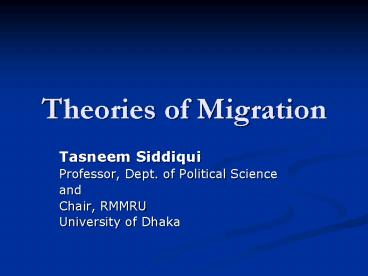Theories of Migration - PowerPoint PPT Presentation
1 / 10
Title:
Theories of Migration
Description:
Geographic difference in demand and supply for labour ... network of institutional relationships of mutual acquaintance and recognition ... – PowerPoint PPT presentation
Number of Views:1489
Avg rating:3.0/5.0
Title: Theories of Migration
1
Theories of Migration
- Tasneem Siddiqui
- Professor, Dept. of Political Science
- and
- Chair, RMMRU
- University of Dhaka
2
- Causes of Migration
- Dr. Tasneem Siddiqui
- Consequences of Migration
- Dr. Ganesh Gurung
- Recent Theoretical Approaches
- Mr. Jeetendra Soni
3
Theories Causes of Migration
- Aim
- To understand why some people migrate and others
do not - Variety of theoretical models available
- Social scientists from different disciplines
4
Neo-Classical Economics
- Macro-Economic Models of Neo-Classical Economics
- Geographic difference in demand and supply for
labour - Surplus of labour compared to capital will have
lower wage rate - Limited supply of labour compared to capital will
have high wage rate causing movement of wage
labour - (Lewis, 1954 Ranis and Feni 1961 Harris and
Todaro, 1970 Todaro, 1976)
5
Push-Pull Framework
- Equal pressure of pull from receiving country and
push from sending countries jointly contribute to
migration - Migration brings certain equilibrium between
forces of economic growth and contraction among
different geographical regions of the world - Two equally important forces one operational at
the country of origin and the other at host
country, jointly create migration
6
Micro Economic Model
- Human Capital Theory/Rational Choice Theory
- Rational economically based decision of the
individual to maximize return to his/her human
capital over space - Person is likely to migrate if expected income is
greater in a location other than where his
currently residing. - Desire for income maximization
- Difference in wage
- Difference in employment opportunity
- (Sjaastad, 1962 Todaro 1969)
7
Critique of Neoclassical Theories
- New economics of migration
- Neoclassical theories explain migration pattern
of industrial era, but current day migration is
more complex - Economic disparities appear to be necessary but
not sufficient condition for todays migration - In the 1990s push and pull factors not equally
operational - Strength of pull factor has weakened due to
restrictive admission policies of the receiving
post-industrial states - Decisions to migrate is not made by isolated
individuals, rather it is arrived at collectively
by larger family units and communities - Migration not only maximizes expected income but
also minimizes risks of market failure - Migration is a risk reducing strategy, not for
individual but for the household
8
Historical Structuralist School
- Broader social and historical forces created
conditions of widespread inequalities in access
to resources, political power and prestige with
and across communities which both stimulate and
constrain migration - (Singer, 1971-75 Stern 1988)
- Social Capital Theory
- Social capital is the sum of resources, actual or
virtual, that accrue to an individual or a group
by virtue of possessing a durable network of
institutional relationships of mutual
acquaintance and recognition - People gain access to social capital through
membership in network
9
Social Capital Theory (contd.)
- Kinship, friendship and shared community, origin
- Network increases the likelihood of migration by
reducing cost and risk - Private recruiting agencies
- Information, trade links, higher education links
- (Bouriu and Wacqueant 1992)
10
Conclusion
- Migration decisions are arrived through a complex
process - It is not possible to explain migration decisions
by a single theory - A holistic perspective derived from
historical-structuralist, push-pull, rational
choice, social-network provides a better tool.































